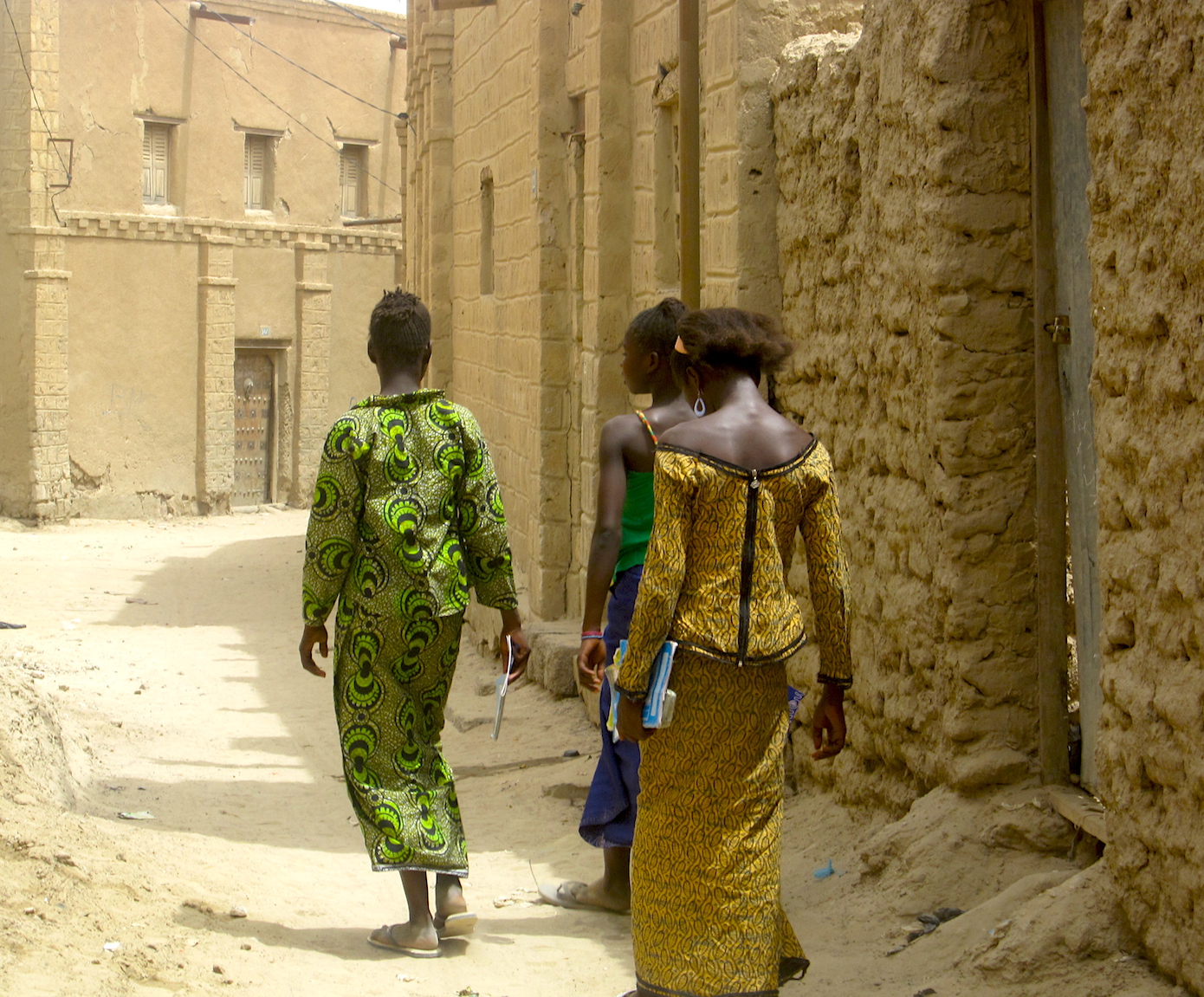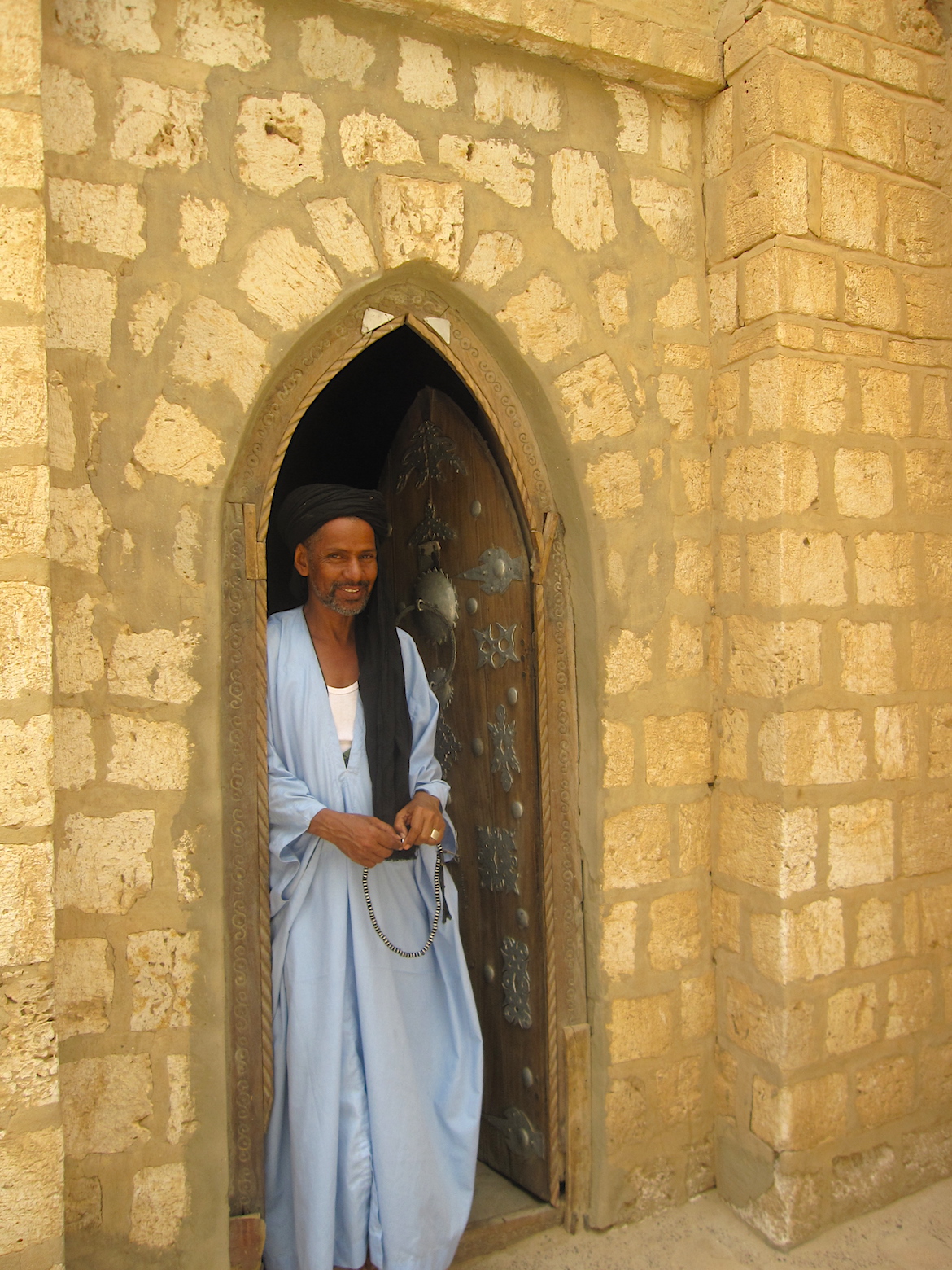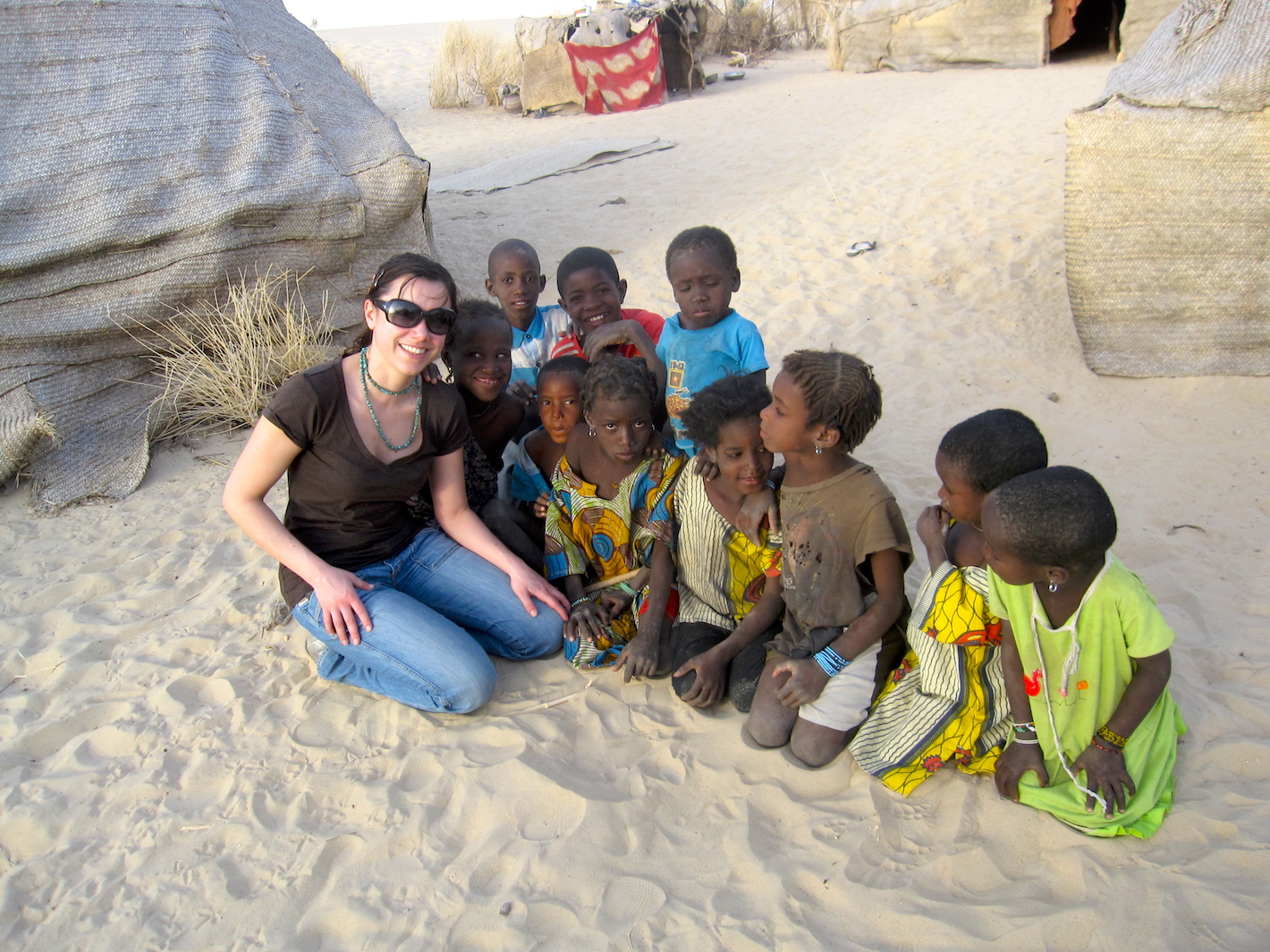How To Get To Timbuktu
Girls going to school in Timbuktu. Photo: Patti Neves
The truth: I arrived in Timbuktu with Air Mali, directly from Bamako, proudly displaying a fake wedding ring (I was single at that time).
Getting there by plane it does look like cheating, but my time for this trip was very short.
Furthermore, I had read about the local customs and sadly understood that in Mali, the only women who used to travel alone were prostitutes... so I made up a plan: like the Scheherazade of the "one thousand and one nights", I would tell the local people a new story everyday (and my favourite story was the one where I was going to retrieve my husband at the next stop)...
These "little lies", protected me from being disturbed, so I could just keep moving around the country.
Not that it didn't raise other questions. Many locals simply didn't understand the concept of "traveling to meet other cultures" and were amazed that my husband would let me travel alone, even in between cities (ha ha).
My Tuareg guide and I, heading to the camp site in the Sahara. Photo: Patti Neves
Travelling, by Malian standards, is something people do for business, sales or seasonal changes with the family (nomadic tribes).
When it comes to cultural diversity and ethnicity's, Mali is a very rich country, but you must not forget that after all, it is still a very conservative place with 90% of Muslims (now controlled by Islamic fundamentalist groups), so I advise everyone to do a lot of research on any destination before even start planning.
Concerning women travelling alone (specially in Subsaharan Africa), it is part of my personal belief that it is always possible to maintain dignity and go to ANY place of this world, without fear.
Of course, depending on where you are, some basic little lies or some "funny clothing" (e.g. burkhas) can be helpful to get around in safety. Oh well...
HOW TO GET TO TIMBUKTU
As detailed before, a Bamako-Timbuktu flight was my only solution to get there in time but as I did not have a return flight, I made the return trip by ferry, hitchhiking and later by foot (4 days trekking in Dogon country), so it is always possible to arrive (or depart) by land, although the travel times can be very long and unpredictable.
According to Air Mali, flights are currently suspended until further notice, so make sure to read the GOV.UK reports before planning any trips in the area.
Sankoré mosque, Timbuktu (Mali). Foto: Patti Neves
There are several options to get to Timbuktu by land, and from Mopti it is possible to go by 4x4 (a two day trip) with a few points of water supply on the way. You can also head there directly from Douentza.
The only way of getting to Timbuktu by road is crossing the Niger (river). In any case, you will need to reach Kabara (or Kouriomé) by boat.
Kabara is the former Timbuktu's port. During the colonial period, the French used slave labour to dig a narrow canal linking Timbuktu to Kabara, but this chanel keeps filling up with sand.
When the water is high enough the COMANAV ferry still docks on Kabara instead of Kouriomé. Zoom on the Map below (my full return itinerary) to understand where these locations are.
Only local people will be able to advise you about the situation today.
For more details I recommend to call COMANAV (Compagnie Malienne de Navigation): +223 21 26 20 94. Please be aware that Mali's main language is French and this is not a very touristic route. Patience is a virtue.
Timbuktu is a few kilometers away from the Niger and once that crossing is made, there is a paved road leading to city.
AND WHY GO TO TIMBUKTU?
It is interesting to know that the legendary Timbuktu (currently a UNESCO heritage site) was long considered unreachable by ancient explorers who believed that the city, hidden in the middle of the desert, would be made of gold. Doubts about the exact location (not to say the very existence of it) were grounds for contests between the British and French, eager to be the first to map the place.
In those times, Timbuktu was an oasis where salt, gold, spices and dyes exchanges were practiced between the Muslim and Tuareg nomads. Some European explorers managed to find the city, but never came back alive to tell the tale, which added to the mystery.
An Englishman even ended up beheaded by the Tuaregs just before leaving the city (as they feared that Timbuktu might then be invaded by settlers).
A man poses at the Sankoré university. Photo: Patti Neves
All changed in 1828, as a Frenchman named René Caillé, disguised as a muslim, managed to visit the city and come back. According to him, Timbuktu was "a mass of ill-looking houses, built of earth" and there was no gold on the walls.
René eventually won a prize of 10,000 francs from the French government and the title of "Knight of Honor" granted by the French Geography Society but still had to respond to British criticism before having his reports recognized as genuine.
It was not until the 1890s that Timbuktu was formally incorporated into the French colony of Mali.
WHAT TO DO IN TIMBUKTU:
Apart from visiting the two most important mosques (La Grande Mosquée Djingareyber and Sankoré), it is possible to visit the house where René Caillé lived. The houses of the explorers who died before getting out of Timbuktu are also marked with plates (some are privately owned).
Among other cool things to do which I liked the most, discovering the buildings entirely made of mud (known as crépissage technique), meandering within the markets of the region, spending time with nomadic tribes or even heading out on a camel expedition to sleep in a Tuareg camp.
THE SANKORÉ UNIVERSITY AND THE ARABIC MANUSCRIPTS
Despite the lack of "gold", René Caillé certainly had the opportunity to find the presumed oldest university in the world: L'Université de Sankoré de Tombouctou, the main learning center of Islamic culture in the desert.
Ancient manuscripts (700,000 in total), written in various styles of the Arabic script and date back to as early as the 13th century were collected in Timbuktu, later scattered through several libraries.
Part of the manuscripts could be visited in the "Bibliothèques familiales des Imams Essayouti" a few years ago.
Guided visit of Manuscripts, Timbuktu. Foto: Patti Neves
When I was there there was a guided tour, but a suicide bombing in the vicinity in September of 2013 shuddered some basic structures, which affected the visits.
According to the ONU website, three libraries were rehabilitated in 2015, including the library mentioned above.
The most up-to-date information can be found at the British Library (2018) which is now undertaking the digitization of these libraries in situ, where work is underway since October 2017.
STREET MARKETS AND THE GRAND MARCHÉ
The main Timbuktu’s market is the Yobou Ber, which means Grand Marché (big market) in Songai, located in Badjinde, the heart of the old centre.
The Grande Marché was rebuilt in Sudanese style (2003), and it is possible to get a nice view of Timbuktu from the rooftop. There is also a place serving meals and you can get a couscous for very cheap.
Furthermore, in the adjacent streets around you will find an interesting street market.
In the image below, a woman walks past a "butcher's shop," a little stall with random pieces of meat (and flies) on the street.
Around Timbuktu's main market. Photo by: Patti Neves
There are a multitude of unidentifiable products, and regular surreal scenes (e.g. animal viscera hanging from a clothesline or a woman crushing something with a giant pestle) can make you feel like you are back in time.
Market street in the surroundings of the grand-marché of Timbuktu. Foto: Patti Neves
White balls of shea butter, the size of tennis balls, are stacked in basins and can be used as exchange money, waterproof wax, hair conditioner, cooking oil and candle material.
Sometimes I could not really understand the scenes I was witnessing and it felt like entering a parallel dimension (which I did not suspect to exist in the 21st century).
This kind of market may seem uninteresting to those who are not into African culture or unattractive for those disturbed by pure and raw poverty, but in poor countries like Mali, the cultural wealth of the people certainly makes up for the lack of money.
After all, what means being "rich" anyways? What is the exact value of a piece of paper?
A woman prepares artisanal beer in a street of Hombori, Mali. Photo: Patti Neves
THE NOMADIC TRIBES OF MALI
Of the most spectacular things I have discovered on this trip is the fact that some tribes still practice barter, exchanging things with each other.
For example, nomads of the Bozo ethnic group specialize in fishing, and move their tents as the river floods, always bringing fish to market. The vegetables usually come from the Dogons, well-known farmers. Salt comes with the camels, brought by the Tuaregs and finally some other tribes (such as the Fulani) specialize as cattle herders.
There are many other tribes in Mali, such as the Mande (which includes the Bambara, Dialonke, Dyula, Malinke, Mandinka, Mende, Soninke, and Susu) just to mention a few...
My Tuareg guide and I in the base Sahara camp, North of Timbuktu. Photo: Patti Neves
I enjoyed so much the opportunity to travel to a Tuareg Camp!
It is very difficult to imagine that caravans with hundreds of camels still depart from that place, and that they travel 800 km across the dunes "only" to bring salt to Timbuktu (their main source of income).
The Tuaregs subsist practically of rice and dried meat, since water is an extremely rationed good.
Some children living near the Tuareg base-camp, North of Timbuktu. Photo: Patti Neves
Each nomad tribe has its place in society and usually survive without money worries, helping and respecting each other.
I was particularly impressed by the fact that they don't use watches, don't have documents, and never worry about precise times to perform tasks in the future. The discovery of living only in the present, was sensational.
Sometimes I would get annoyed when trying to catch a bus, only to find out people telling me that the bus would "pass once a day", and people interested would indefinitely wait under a tree. I tried doing that only once, during this trip through Mali, but this lasted a whole afternoon. What an exercise!
Not only in Timbuktu but also in Mopti and Ségou, I had also the amazing opportunity to visit other nomadic tribes and to talk to a Fulani woman (Peul in French), a tribe who still practices the painful ritual of the black tattoo (tchoodi) around their mouths. This custom is used between them as proof of courage and a way to become more attractive, according to the local culture.
Fulani women (Peul) with the tchoodiaround their mouths. Photo: Patti Neves
Full explanation of tattoos on the Pulaku website (do not click on this link if you have a sensitive stomach).
HOW TO LEAVE TIMBUKTU
There are no buses from Timbuktu, not even to the ferry, so it is still difficult to reach (and leave) this lost city.
In my case, I ended up getting a ride in a 4x4 with my Tuareg guide's cousins, who were going to Hombori, (but many people go straight to the Douentza and then start the trek in Bandiagara, pays Dogon).
The trekking was in my plans as well, but since I had found "acquaintances who were more or less heading the same way" I would not have to worry about transportation or accommodation, at least until the next destination.
Ferry leaving Timbuktu. If you hate being surrounded by tourists, this place is the place for you. Photo: Patti Neves
As I explained in the first post, the purpose of my trip to Mali was to take a solidarity trip where I would stay at the local's places in exchange of a donation (instead of staying in hotels) and this ended up allowing me a great flexibility besides the unique opportunity to rely entirely on human empathy.
On the other hand, I had no idea how I would get from Hombori to Bandiagara (from where I was supposed to leave for a the trek in few days).
The day I left Timbuktu, the thermometer was at 42 C, and following a few hours drive, we got a flat tire.
We had half a bottle of lukewarm water for 4 adults and we were hungry.
I mean real hunger, the one where your the stomach hurts. There were no stops on the road to eat anything. By the way, any "road" barely existed as seen in the photo above.
The Harmattan (devilishly hot wind of the Sahara) was hitting that day and we had almost no visibility. We were breathing lots of dust.
I remember spending hours spitting out a dark phlegm while waiting impatiently under the imaginary "shadow" of a dry tree. This tire change, in my perspective, lasted for about 3 days... (#notreally) but some doubts started crossing my mind.
I was agitated and a little worried. I realized that having worrying was a strong characteristic of pessimistic people, and I could not afford to be pessimistic in such a vulnerable situation.
I resigned myself to the circumstances and was suddenly happy! I was there by my free will, and for the first time in my life I was seriously questioning my own thoughts...
Today I see that we can easily forget the name of that stunning beach where we wet our feet for the first time in Bali... but never that feeling of having matured years after a few hours of difficulty.
That's why we travel, to change ourselves.
The report continues in the post "Trekking in Dogon country and Djenné visit" (expected date: July 28, 2018).
To save this post on Pinterest, hoover over the image below and click on the Pin:


















